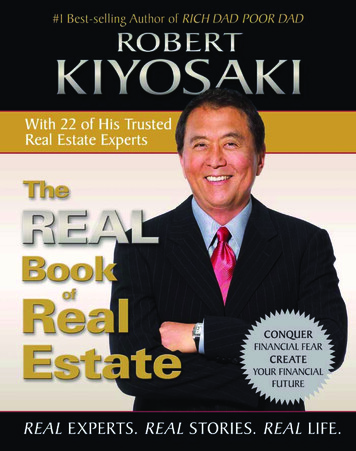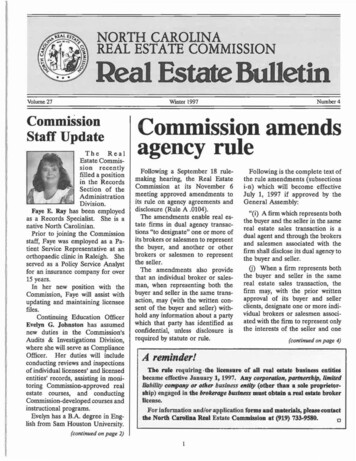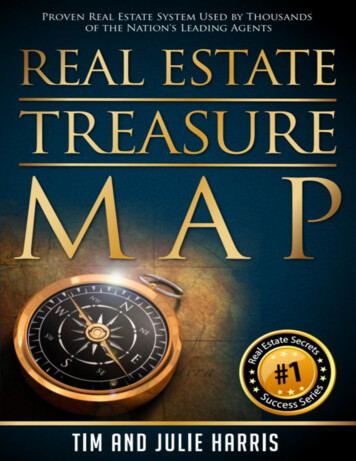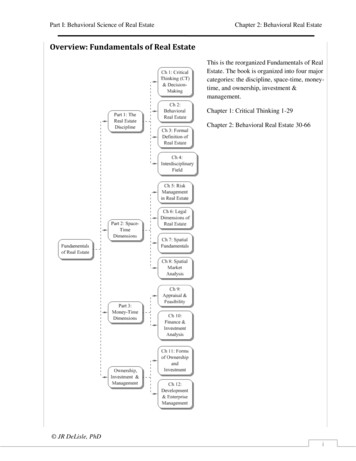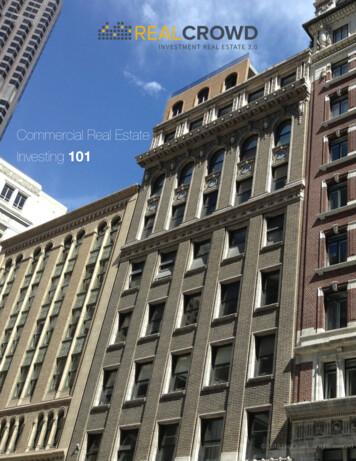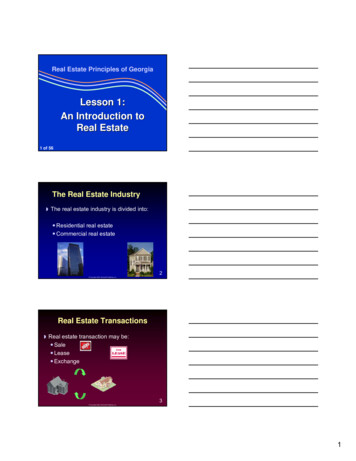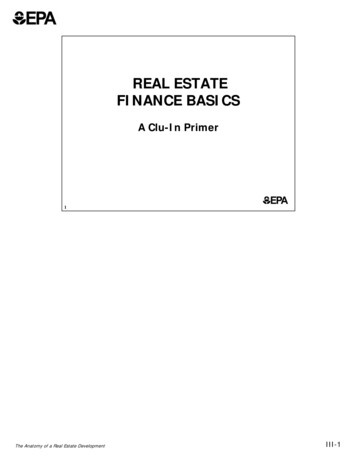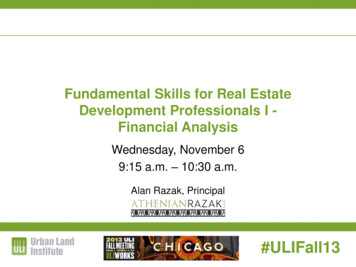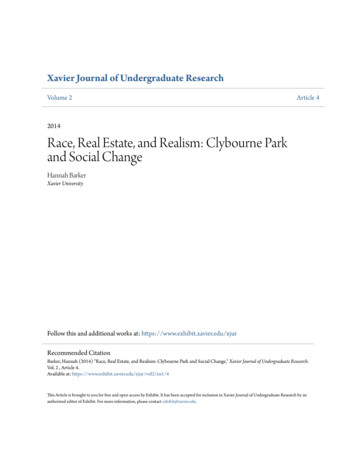
Transcription
Xavier Journal of Undergraduate ResearchVolume 2Article 42014Race, Real Estate, and Realism: Clybourne Parkand Social ChangeHannah BarkerXavier UniversityFollow this and additional works at: https://www.exhibit.xavier.edu/xjurRecommended CitationBarker, Hannah (2014) "Race, Real Estate, and Realism: Clybourne Park and Social Change," Xavier Journal of Undergraduate Research:Vol. 2 , Article 4.Available at: s Article is brought to you for free and open access by Exhibit. It has been accepted for inclusion in Xavier Journal of Undergraduate Research by anauthorized editor of Exhibit. For more information, please contact exhibit@xavier.edu.
Race, Real Estate, and Realism:Clybourne Park and Social ChangeHannah BarkerThere is no political value in having sensitive feelings about the world. I don’tthink it generates political action. You go [to the theatre], you watch, you say,“That’s sad,” and then you go for a steak. The best you can hope for is to makepeople slightly uncomfortable. At least if you take the piss out of the audience,they feel they are being addressed.--Bruce Norris, author of Clybourne ParkThroughout my final semester as an undergraduate English major, I have beenseeing more plays—both ones I have read in class and ones I have not—in orderto gain a better understanding of the theatre world. One play that had a big impacton me was Clybourne Park, which I saw in January at Playhouse in the Park, inCincinnati. Clybourne Park was written in 2011 by Bruce Norris. It has woncountless awards, including the Pulitzer Prize. Clybourne Park picks up whereLorraine Hansberry’s famous A Raisin in the Sun left off; Act I takes place in1959. A white, middle class couple, Russ and Bev, is moving out of their allwhite neighborhood of Clybourne Park. A black family, the Youngers from ARaisin in the Sun, is moving into the house. Karl Lindner, the same Karl fromHansberry’s play, tries to convince Russ and Bev to either stay, or not allow theblack family to move into the neighborhood. Act II is set fifty years later in 2009.The same actors play these characters, and the audience can pick up on manyparallels between the 1959 scene and the 2009 scene. In Act II, Clybourne Parkhas become an all-black neighborhood, and a white family is trying to move intothe same home from Act I and re-gentrify it by essentially tearing the house downand rebuilding it. Here, no one seems to have changed: in both scenes, thecharacters are uncomfortable discussing race. They are defined by theirdifferences and refuse to accept others who are different.Clybourne Park addresses tough, but relevant, social issues with whichaudiences from almost any city can identify. For me, the play brought to mindCincinnati’s Over-the-Rhine (OTR) neighborhood. This area of Cincinnati iscurrently experiencing gentrification and has had issues with race and property inthe past—especially with the 2001 race riots—so Clybourne Park, which does notXJUR, Volume 2, July 201434
XJUR / July 2014have a “happy ending,” made me curious about the intersection of race andproperty in Cincinnati currently. What is the right action to take in thedevelopment of OTR? Has the city made any positive progress? WatchingClybourne Park also made me question the value of theatre. Are the concepts inthis play more effective because they are on a stage? Can this play make adifference in places like OTR, since it exposes some of society’s problems? Asthis essay’s epigraph reveals, playwright Bruce Norris does not see theatre ascapable of creating much social change. Sure, it can make people uncomfortable,but that’s “the best you can hope for” (Norris Interview by Beatrice Basso).Through this paper, and using Clybourne Park as evidence, I will show thattheatre is capable of promoting social change. Based on studies of art and moderndrama, and the events that surrounded Clybourne Park’s premiere in Cincinnati, Iwill challenge Bruce Norris’s negative outlook on modern drama’s ability tomotivate social action for the better.First, I will explore theories about art in general and how art has the abilityto influence people’s actions. Then, more specifically, I will address moderndrama and what theorists have discovered about its ability to influence socialchange. As part of this analysis, I will include examples from Clybourne Park toshow how it fits in with the power of modern drama. I will follow this discussionby illustrating how modern drama can be more effective than the novel or otherforms of art that promote pro-social messages. Finally, I will delve more intoOTR and the parallels between it and Clybourne Park, addressing how so far, theeffects of the play on the city prove hopeful for the future of Cincinnati, theatre,and theatre’s ability to act as a catalyst for change.Art’s Ability to InfluenceArt’s relationship to social order is both complex and highly controversial;however, there are many examples supporting how art can show a general conceptin a particular context to help people better understand themselves and createchange in their society. According to Emma Goldman in The Social Significanceof Modern Drama, people can view the purpose of art in two ways: “art for art’ssake” and “art as the mirror of life” (3). The former occurs when the artist showsindifference toward the complex struggles of life. But the latter is central tomodern art. Goldman claims, “The artist being a part of life cannot detach himselffrom the events and occurrences that pass panorama-like before his eyes,impressing themselves upon his emotions and intellectual vision” (3). It isdifficult for the artist, who is a part of society, not to reflect what he sees andexperiences in society in his works. This is why art is so relatable to many people:it is created by humans who share the same experiences as the viewers. Norris,seeing the separation of race in his all-white neighborhood as a kid, wroteClybourne Park after this experience. He comments in an interview with BeatriceBasso, “At any given moment, you know that even something as insignificant astaste—‘I like this house better than that house, it’s prettier’—identifies us as partof a group that looks at another group skeptically or critically” (147). Norris’35
Barker / Clybourne Parkcharacters are pitted against each other in these “groups”: Karl, Betsy, and Jimagainst Francine and Albert in Act I and Lindsey and Steve against Lena andKevin in Act II. Clybourne Park is realistic and relatable because Norris cannotremove himself from this reality of separation.D.W. Gotshalk also points out many of the contributions art offers tosociety in Art and the Social Order. He says that the creation and appreciation ofart include similar emotions to social action, such as senses, feelings, imagination,and intellect. He writes, “fine art transforms what social action everywhereembodies and is thus implicitly a social force in the very creation and appreciationof an object which serves purely aesthetic purposes” (204). While Gotshalk pointsout that art and social action trigger similar responses, he recognizes that art alonecannot create permanent social change. Gotshalk asserts that the artist is limitedbecause he cannot control external circumstances, which affect the influence arthas on a society. Art must work with the society it has the ability to change:“Unless a work of directive art is bulwarked by pressures and terrors fromelsewhere, by a critical situation such as a war, a national calamity, an economicor moral crisis, its message is likely to seem artificial and labored and its pointirrelevant” (205). This makes sense, because if a play makes the audience thinkabout the negative effects of violent wars, and there is no war going on in thisparticular society, the message appears irrelevant—why make a change to anissue that doesn’t exist? Clybourne Park exists alongside the real gentrificationand race issue in OTR and other large cities; therefore, these outside pressuresmake the Clybourne Park neighborhood a more resonant experience for itsviewers.Gotshalk also notes that art is not magic; it cannot make everythingperfect. What artists can do is, “[i]n creation and appreciation they can increasethe range of our sensory and imaginative grasp, enlarge the scope and subtlety ofour feelings and insights, preserve and strengthen a large sheaf of the finer andrarer values of human existence—creativity, originality, spontaneity” (213). Theabilities of the artist can lead to social action, since people tend to act based onwhat they think, feel, value, see, etc., which are aspects the artist has the ability toinfluence. Artists can modify people’s characters in a way that leads to socialaction; they can make “the mind more flexible, receptive, discriminate, andresponsive” (212). In order to change people in this way though, the artist alsoneeds recognition from society: “society is required to recognize difficulties to thegood confronting itself and a unity of belief increase and multiply (as far asharmonious with general welfare) seek, rather than to force, the co-operation ofthe artist [and] stimulate alert, informed, and critical attention to the works ofthe artist” (228). According to Gotshalk, all of these aspects must be present forart to have its maximum effect. It is unlikely that any society has ever fulfilled allof the requirements, but many have been close (229). Art helps keep society incheck by exposing its violence and hostility; however, in order to be fullyeffective, people need to seek out the art.36
XJUR / July 2014Additionally, art needs society to see and recognize the parallels betweenthe play and society’s own experiences. If Cincinnati views the events inClybourne Park with a critical eye, as a platform for changing the economics ofthe city, then this play could help people understand the underlying racial andsociological issues involved in OTR gentrification.The Social Role of Modern DramaWhile drama has always had an influential role in society, the era ofmodern drama further increased theater’s power to spur change. Starting roughlyin the era of Ibsen’s plays, theatre turned toward a new style: modern drama.Many critics view modern drama as a more realistic type of theatre—one whichexposes the atrocities of society by showing viewers an outsider perspective ofwhat society is actually like. Martin Esslin in An Anatomy of Drama describesmodern theatre as “a mirror which society looks at itself” (103). For example, thefact that “at certain times the theatre tended to show only middle-class people tomiddle-class people demonstrates that in those times the lower classes wereeffectively excluded from society and therefore from the theatre” (Esslin 103).Clybourne Park is one of these types of plays. Only the middle-class charactersare shown to a presumably middle-class audience. Viewers don’t get to see theblack family who is trying to purchase the house in 1959. They don’t get to seeany poor characters, which suggests that these people don’t have any say insociety, or, at least in the case of Clybourne Park, any say in the issues of raceand gentrification. Norris comments on his choice for the kinds of characters hecreates:People ask how come I don’t write plays about, say, people in housingprojects, and I say, “Well, because those are not the people who go to thetheatre.” You can say, “We should get them to the theatre,” but in actualfact, people who buy subscriptions to theatres like ACT are usuallywealthy people. They are almost always wealthy, liberal people. So whynot write plays that are about those people, since those are the people whoare in the audience? If you actually want to have a conversation with thataudience, then you should address them directly. That’s what I alwaysthink. (Interview with Beatrice Basso 148)If an audience sees a mirror image of a society they don’t recognize, or they don’tfeel responsible for, then the effect of the artist is more likely to be lost. Thoughthe audience for Clybourne Park removes itself for the most part from the 1959scene, which is right in the middle of the Civil Rights Era, it cannot remove itselfas easily from the 2009 scene. The parallels between the scenes are so clear thatthe audience sees a poor mirror image of itself and hopefully feels uneasy aboutthe way society is portrayed; this feeling, along with if they recognize theirsociety in the one on stage, makes the audience hopefully want to fix the problem.37
Barker / Clybourne ParkA playwright’s rendering of society therefore plays an important role inthe social effect of the play. Esslin writes, “The more completely a playwrightimagines a situation and the characters in it, the nearer the play will come to thecomplexity and ambivalence of the real world” (Esslin 98). Norris effectivelycreates this realistic scene with his play, especially in Act II. The charactersNorris creates are extremely complex. Norris, to Beatrice Basso, comments on thecharacters’ interactions: “Everyone holds their tongue, because we live in asociety where speech is much more dangerous than activity—than action . . . . Noone knows that they should be embarrassed in the first act; everyone knows theyshould in the second act. We’re embarrassed about everything” (149). Theaudience can somewhat forgive or at least roll their eyes at the racist and closedminded attitudes of the characters in Act I. For example, Karl approachesFrancine, the black housekeeper for Russ and Bev. He asks her about skiing as away to prove that blacks and whites cannot live together because they aredifferent:KARL: Francine, may I ask? Do you ski?FRANCINE: Ski?KARL: Downhill skiing?FRANCINE: We don’t ski, no.KARL: And this is my point. The children who attend St. Stanislaus. Oncea year we take the middle schoolers up to Indianhead Mountain, and I cantell you, in the time I’ve been there, I have not once seen a colored familyon those slopes.
Clybourne Park is realistic and relatable because Norris cannot remove himself from this reality of separation. D.W. Gotshalk also points out many of the contributions art offers to society in Art and the Social Order. He says that the creation and appreciation of art include similar emotions to social action, such as senses, feelings, imagination, and intellect. He writes, “fine art .
